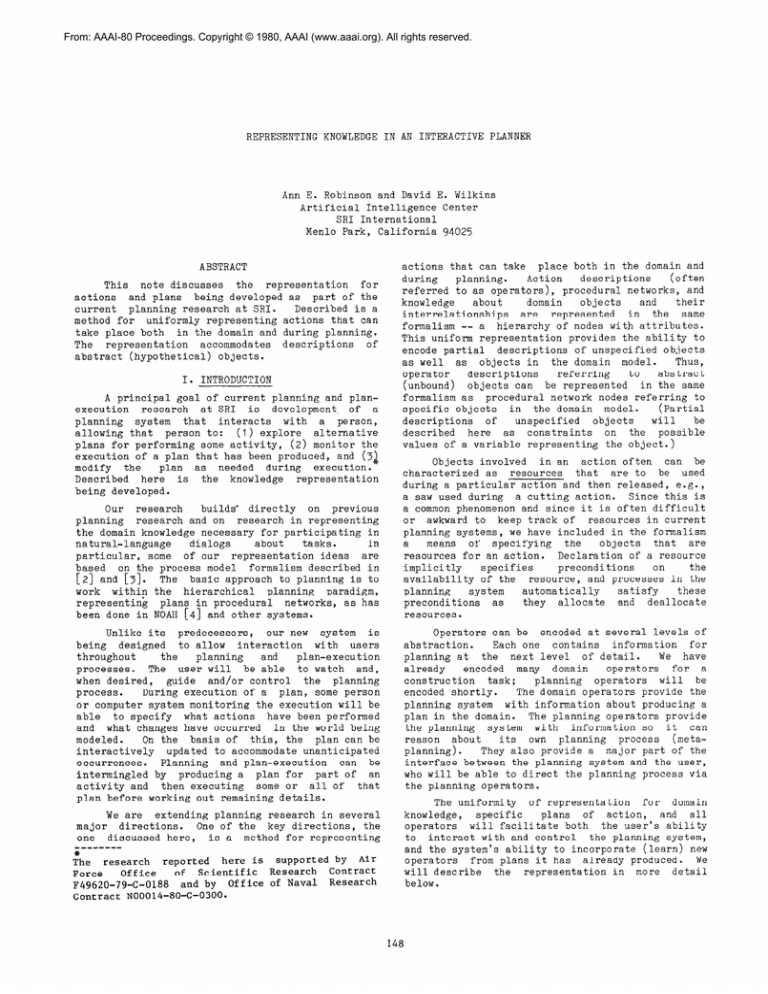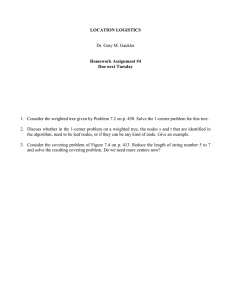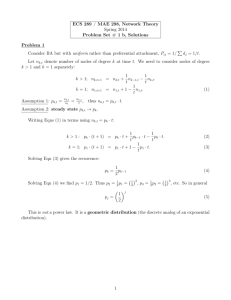
From: AAAI-80 Proceedings. Copyright © 1980, AAAI (www.aaai.org). All rights reserved.
REPRESENTING
KNOWLEDGE
IN AN INTERACTIVE
PLANNER
Ann E. Robinson and David E. Wilkins
Artificial
Intelligence Center
SRI International
Menlo Park, California 94025
ABSTRACT
This
note discusses
the
representation
for
actions
and plans
being developed as part of the
current
planning research at SRI.
Described is a
method for uniformly representing actions that can
in the domain and during planning.
take place both
accommodates
descriptions
of
The
representation
abstract (hypothetical)
objects.
I. INTRODUCTION
A principal goal of current planning and planresearch
at SRI
is development.
of a
execution
planning
system
that
interacts
with
a person,
alternative
allowing that
person to:
(1) explore
plans for performing some activity, (2) monitor the
execution of a plan that has been produced, and (72
modify
the
plan
as needed
during
execution.
Described
here
is the knowledge
representation
being developed.
actions that can take
place both in the domain and
descriptions
(often
during
planning.
Action
referred to as operators), procedural networks, and
their
and
knowledge
about
domain
objects
represented
in
the same
interrelationships
are
formalism -- a hierarchy of nodes with attributes.
This uniform representation
provides the ability to
encode partial
descriptions
of unspecified objects
Thus,
as well
as objects in
the domain
model.
abstract
operator
descriptions
referring
to
in the same
(unbound)
objects can
be represented
formalism as procedural network nodes referring to
specific objects
in
the domain
model.
(Partial
will
be
descriptions
of
unspecified
objects
described
here
as constraints
on
the possible
values of a variable representing
the object.)
Our
research
builds' directly
on previous
planning
research and on research in representing
the domain knowledge necessary for participating
in
natural-language
dialogs
tasks.
In
about
particular,
some
of our
representation
ideas
are
based
on the process model
formalism described in
The
basic approach to planning is to
[2] and [S].
work
within the hierarchical
planning
paradigm,
representing
plans in procedural
networks, as has
been done in NOAH [4] and other systems.
Operators can be
encoded at several levels of
abstraction.
Each one
contains
information
for
We have
planning at
the next level
of detail.
operators
for a
already
encoded
many
domain
will
be
construction
task;
planning
operators
The domain operators provide the
encoded shortly.
planning system
with information about producing a
plan in the domain.
The planning operators provide
the planning
system
with
information so it can
reason
about
its
own
planning
process
(metaplanning).
They also provide a major part of the
interface between the planning system and the user,
who will be able to direct the planning process via
the planning operators.
Unlike its predecessors,
our new
system
is
being
designed
to allow
interaction
with
users
the
planning
throughout
and
plan-execution
processes.
The
user will
be able
to watch
and,
when desired,
guide
and/or control
the
planning
During execution of a plan, some person
process.
or computer system monitoring the execution will be
able
to specify
what actions
have been performed
and
what changes have occurred
in the world being
modeled.
On the basis of this, the
plan can be
updated to accommodate unanticipated
interactively
and plan-execution
occurrences.
Planning
can be
part of an
intermingled
by
producing a plan for
activity and
then executing
some or all of
that
plan before working out remaining details.
The uniformity
of representation
for
domain
and
knowledge,
specific
plans
of action,
all
operators
will facilitate both
the user's ability
to interact with and control
the planning system,
and the system's ability to incorporate
(learn) new
operators
from plans it has
already produced.
We
will describe
representation
in more
detail
the
below.
We are
extending planning research in several
major
directions.
One of the
key directions, the
one
discussed here,
is a method for representing
-------+
reported
here is supported by Air
The
research
of Scientific
Research
Contract
Office
Force
Research
F49620-79-C-0188
and by Office of Naval
Contract N00014-80-C-0300.
148
II. THE FORMALISM
meat1 has been constrained
to be a fish
FIX.MEAL,
it was
so
(denoted by
calling it "fishl") since
constrained
in the node being expanded.
The formalism for representing
knowledge about
and domain
actions,
plans,
objects
consists
of
nodes linked in a hierarchy.
Each node can
typed
have attributes associated with it.
There are four
CLASS,
representing
objects:
node
types
for
These will
INSTANCE, INDEFINITE,
and DESCRIPTION.
not be discussed in more detail here since they are
similar
to those
occurring
in re resentation
formalisms such as KRL, FRL, and UNITS -f51.
OPERATOR
FIX.MEAL
RESOURCES.
meat 1, vegl
GOAL
(PREPARED
meat 1)
RES. meat1
The node types for representing
actions can be
grouped into four categories:
OPERATOR, for encoding operators;
PNET, for representing specific actions (nodes
in the procedural network);
PLOT, for describing how to expand a given
OPERATOR, i.e., a description of an action
in greater detail;
PNET.ACTION,
for encoding plan steps (procedural
network nodes) that have been 'executed' and
thus represent actions assumed to have
occurred in the world being modeled.
-
f
JOIN
SPLIT
-
PROCESS:
SERVE
RES
GOAL:
(PREPARED
vegl)
RES: veg 1
A PNET node which represents usmg FIX.MEAL
Nodes can have
lists of attributes and can be
connected
into
a hierarchy
through
CLASS
and
links.
Attributes
of
nodes
for
SUBCLASS
representing
actions
include
the
resources
and
arguments of
the action
(i.e., the
objects
that
participate
in the
action), the action's goal, the
action's
effects
on
the domain
when
it is
performed,
the
preconditions.
and
action's
which
have
a
OPERATOR
nodes
plot
attribute
specifies PLOT nodes for carrying out the operator.
. . .
PROCESS.
FIX.MEAL
RESOURCES.
flshl
veg 1
meatl,
vegl
ma plan.
17
. . 0
Expansion of thts PNET node at the next level usmg FIX.MEAL.
The
PLOT of an operator
can be described not
only in terms of GOALS to be achieved, but also in
(Previous
terms
of
PROCESSes
to be
invoked.
would represent
a PROCESS as a goal with
systems
only a single choice
for an action to perform.)
The ability to describe operators in terms of both
GOALS and PROCESSes
will help simplify encoding of
the planning
system
to
operators and will allow
more
alternative
reason
about
action
sequences
efficiently.
Figure
1
In our formalism, such variables are described
by
INDEFINITE
nodes
with
constraints
on
their
PNET
nodes,
possible
values.
For
attributes
frequently
refer
both to variables
(which
will
often be more
constrained
in this case)
and
to
For
PNET.ACTION
completely
specified
objects.
nodes,
attributes
generally
refer
to specific
objects in the
domain model.
The system's ability
to use
INDEFINITE
nodes
to partially
describe
objects is important for representing
objects with
varying
degrees
of abstractness
in
the
same
formalism.
Few previous planning systems have used
this approach (e.g., NOAH cannot partially describe
objects and has different formalisms for describing
Stefik's
operators and
procedural nets).
system
descriptions
does
abstract
and
allow
[51
constraints
on partially
described arguments, but
arguments are
required
to be
fully
instantiated
before the constraints can be evaluated.
(See also
Hayes-Roth et al.
cw
Figure
1 shows
a sample operator
and a PNET
the
it might
produce.
The
figure
illustrates
uniformity
across different types of nodes in our
formalism.
The
nodes are
expressed in the
same
have the same
formalism,
and, for the most part,
attributes
(e.g.,
resources,
shared-resources,
with
similar
preconditions,
arguments,
purpose)
values
for
these
attributes.
"Similar
values"
means
that the values
refer to the
same types of
objects -- often the value of an attribute for some
node will be more constrained than the value of the
same
attribute
in
a corresponding
node
of a
different
category.
The
next
two paragraphs
illustrate
this in detail, after which we describe
where
the uniformity
of
the
two
instances
representation
is advantageous.
Attributes
in OPERATOR
and
nodes
PLOT
refer to variables
rather than specific
generally
since these
are uninstantiated
operators
objects,
instantiated
into
PNET
nodes
in
that
may
be
different ways
during planning.
For example,
in
Figure
1 resource variables
meat1
and vegl in the
operator FIX.MEAL refer
to objects of the meat and
vegetable class, respectively.
In the expansion of
The uniformity
of representation
between PLOT
and PNET nodes permits the description of operators
what
as
amounts
to
generalized
fragments
of
procedural
network.
This
turns
problem
solving
into
a process
of incremental
instantiation.
incrementally
During
planning,
PNET
nodes
are
expanded to a greater level of detail by selecting
149
an appropriate operator, determining
which of its
variables
match those in the
node being expanded,
creating
new variable records
for those variables
not
matched, adding
any new
constraints to these
variables,
and
following
the
operator's
plot
description
to create new procedural network nodes.
The
uniformity of representation
facilitates this
production of PNET nodes from PLOT nodes.
Once a plan has been successfully
constructed,
it may be
desirable
to save it for
subsequent
planning
activities,
incorporating
it into
the
system as a new
operator.
We
expect to develop
algorithms
for
doing
this,
i.e.,
producing
an
operator (with its associated PLOT nodes) from PNET
fragments.
For each
control node and each actionoriented
node
in a
procedural
network,
a
corresponding
PLOT node can be easily created for
the
operator
because
of
the
uniformity
of
representation.
The major
task
remaining
in
producing an
operator
would be generalizing
the
constraints
on
values
for
variables
in
the
procedural network nodes into looser constraints in
the new operator.
An
additional uniformity between descriptions
of
specific actions and
operators facilitates the
matching
of an operator
to the node
it is to
expand.
Thus
PROCESS
and
GOAL
nodes
in a
procedural network
or plot will
have
attributes
similar
to
those
of
the
OPERATOR
node
which
represents a more
detailed description
of their
corresponding
action.
The
similarities
of
representation
of
all
action-oriented
nodes
facilitates
interaction with
the user who can talk
in the same
way about operators, steps in operator
plots,
and
nodes
in
the procedural
network.
Similarly, description of actions is facilitated by
this uniformity.
alternative constraints
on variables
relative
to
different
plan
steps.
The
constraints
on a
variable's
value
as well as
the
binding
of a
variable
to
a particular
instance
(possibly
determined
during
the
solution
of a general
constraint-satisfaction
problem)
can
only
be
retrieved
relative to a particular context.
This
permits the user to easily shift
focus back
and
forth between alternatives.
Hayes-Roth et al.
[I]
describe the use of a blackboard model for allowing
shifting of focus between alternatives.
Such focus
shifting
can
not
be done
in systems
using
a
backtracking
algorithm
where descriptions
built up
during expansion
of one alternative
are
removed
during
the backtracking
process
before
another
alternative
is investigated.
Most other planning
systems either
do not allow
alternatives
(e.g.,
algorithm
(e.g.,
NOAH[4]), or use a backtracking
Stefik [5], Tate [6]).
IV. CONCLUSION
We have
described
some
properties
of
the
knowledge
representation
developed
for
our
new
planning system.
Most
of the planner
is still
under
development
(e.g.,
critics, reasoning about
resources,
and
search
control
have
yet
to be
implemented).
The central idea
discussed here is
the uniform representation
of the domain operators,
planning
operators,
procedural
networks,
and
knowledge about
domain objects.
Ways to exploit
this
uniformity are
pointed to.
These include a
rich interaction
with the user, meta-planning,
and
having the system learn new operators from plans it
has constructed.
REFERENCES
Organizing the
representation
as
nodes
with
attributes
is,
of course, not
and
is not
new
essential.
The
representation
also
be
could
expressed in a formal logic (a translation to logic
would
be fairly straightforward).
We have chosen
to
represent
things
as nodes
with
attributes
because
this
blends
well
with
our
plans
for
interaction
with the user.
III. PARTIAL
DESCRIPTION
USING
1.
Hayes-Roth,
B., F. Hayes-Roth, S. Rosenschein,
S. Cammarata,
"Modeling
Planning
as
an
Incremental,
Opportunistic
Processll, In Proc.
IJCAI-79. Tokyo, Japan, August, 19791 pp. 375-
383.
CONSTRAINTS
Stefik's
system [5], one of the few existing
planning
systems
with the ability
to construct
descriptions
of
an
partial
object
without
identifying
the object,
contains
a constraintposting mechanism
that allows partial descriptions
similar to those
described above.
Our system also
provides for partial description using constraints,
and extends Stefik's approach in two ways.
Unlike
Stefik's system,
our
system
permits
evaluation of constraints on partially
described
objects.
Both
CLASSes
and
INSTANCES
can have
constraints.
For
example, a set can
be
created
which can be constrained
to be only bolts, then to
be
longer
than
one inch
and
shorter
than
two
inches, and
then to have hex
heads.
Our
system
also provides
for partial
descriptions
that
vary
with the
context, thus permitting consideration
of
alternative
plans
simultaneously.
A
context
mechanism
has
been
developed
to
allow
for
3. Robinson, A.E., D. Appelt, B. Grosz, G. Hendrix,
and
J. Robinson,
"Interpreting
NaturalLanguage
Utterances in Dialogs About Tasks",
Technical
Note 210,
SRI International,
Menlo
Park, California. March, 1980.
4.
Sacerdoti,
Behavior.
1977.
E.,
A
Elsevier
Structure
for
North-Holland,
Plans
and
NewYork.
5. Stefik,
M., Planning
With Constraints.
Report
STAN-CS-80-784,
Computer
Science
Department,
Stanford University, Ph.D Dissertation.
1980.
6.
150
Tate,
Proc.
A., "Generating
Project
Networks",
In
IJCAI-77. Cambridge, Mass. August, 1977.






